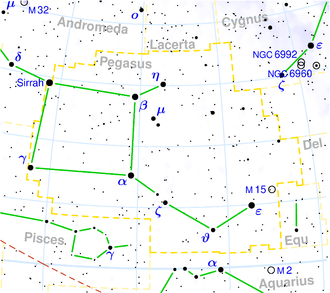IC 1461
| Galaxie IC 1461 | |
|---|---|
 | |
| SDSS-Aufnahme | |
| AladinLite | |
| Sternbild | Pegasus |
| Position Äquinoktium: J2000.0, Epoche: J2000.0 | |
| Rektaszension | 22h 58m 34,3s[1] |
| Deklination | +15° 10′ 22″[1] |
| Erscheinungsbild | |
| Morphologischer Typ | SBc[1] |
| Helligkeit (visuell) | 14,2 mag[2] |
| Helligkeit (B-Band) | 15,1 mag[2] |
| Winkelausdehnung | 0,60' × 0,4'[2] |
| Positionswinkel | 144°[2] |
| Flächenhelligkeit | 12,5 mag/arcmin²[2] |
| Physikalische Daten | |
| Rotverschiebung | 0.030654 ± 0.000050[1] |
| Radialgeschwindigkeit | 9190 ± 15 km/s[1] |
| Hubbledistanz vrad / H0 | (418 ± 29) · 106 Lj (128,3 ± 9,0) Mpc [1] |
| Geschichte | |
| Entdeckung | Lewis Swift |
| Entdeckungsdatum | 20. Oktober 1889 |
| Katalogbezeichnungen | |
| IC 1461 • PGC 70153 • CGCG 430-036 • IRAS 22560+1454 • KUG 2256+149 • 2MASX J22583427+1510223 • Mrk 311 • | |
IC 1461 ist eine Balken-Spiralgalaxie vom Hubble-Typ SBc im Sternbild Pegasus am Nordsternhimmel. Sie ist schätzungsweise 418 Millionen Lichtjahre von der Milchstraße entfernt und hat einen Durchmesser von etwa 75.000 Lj.
Im selben Himmelsareal befinden sich u. a. die Galaxien NGC 7437, NGC 7442, NGC 7448, NGC 7461.
Das Objekt wurde am 20. Oktober 1889 von Lewis Swift entdeckt.[3]
Weblinks
Einzelnachweise
Auf dieser Seite verwendete Medien
Autor/Urheber: Sloan Digital Sky Survey, Lizenz: CC BY 4.0
The sky image is obtained by Sloan Digital Sky Survey, DR14 with SciServer.
Angle of view: 4' × 4' (0.3" per pixel), north is up.
Details on the image processing pipeline: https://www.sdss.org/dr14/imaging/jpg-images-on-skyserver/



